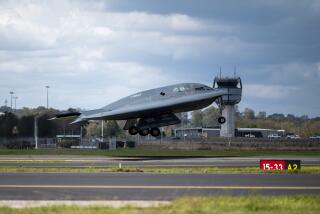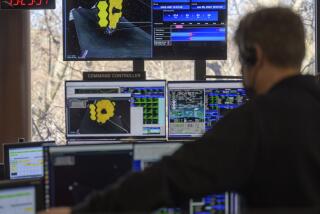Northrop Practically Telling and Showing All to Salvage the B-2
- Share via
The forbidding double rows of barbed-wire fence are still in place around Northrop’s B-2 Stealth bomber plant in Palmdale, but on Tuesday the company opened the controversial bomber’s long-secret assembly line to viewing by reporters.
Amid mounting congressional opposition to the program, Northrop allowed the reporters to enter the facility and provided briefings on the bomber’s radar-evading “stealth” technology, a subject that once was unmentionable by Air Force and company officials.
After a decade of extreme secrecy, it seems that little is being held back in the B-2’s fight for survival. Earlier this year, Defense Secretary Dick Cheney reduced future production from 132 bombers to just 75.
And a fight to kill the program is expected this summer in Congress. An amendment to kill the B-2 program after production of only 15 aircraft has the support of 200 members of the House of Representatives, according to Rep. John Kasich (R-Ohio), a co-sponsor of the legislation.
The B-2 facility shown Tuesday appeared to be a fairly conventional aircraft final assembly line. The large hangar contained just four partially completed B-2s, but it has room for 15 aircraft assembly positions.
The 15 positions were designed with the idea of producing 24 B-2s a year and eventually building a fleet of 132 aircraft, a quantity that apparently will never be produced.
Unlike a conventional aircraft assembly plant with its din of rivet hammers, the B-2 plant was nearly as quiet as a computer factory Tuesday. During a 10-minute observation from a balcony overlooking the plant’s interior, only one rivet gun could be heard.
The B-2 is made largely with composite materials--special fabrics bonded in a plastic resin. The exact materials remain secret, but they are produced in the world’s largest autoclave at Northrop’s parts fabrication plant in Pico Rivera.
Parts arrive in Palmdale aboard giant C-5 cargo jets from an LTV plant in Texas and from Boeing in Seattle. They are joined in the final assembly building at Palmdale, where a total of 800 workers are employed on three shifts. Altogether, Northrop has 2,400 workers in Palmdale. Subcontractors Boeing and LTV employ another 800.
Maj. Gen. Richard M. Scofield, the B-2 program director, said the Air Force has already sunk $26.7 billion into the bomber program, nearly half of the total projected $62-billion cost to produce the 75 aircraft under Cheney’s plan.
But if the program is stopped at 15 aircraft, it will cost $35.4 billion after various contract termination fees and other close-out costs are paid, he argued. Thus, Scofield suggested, the bomber’s unit price is getting cheaper and a cancellation now would not save much money.
“If you lose the United States, is that worth 10 times the gross national profit?” asked Northrop’s B-2 Division President Oliver Boileau. “The unit cost of the aircraft doesn’t mean much.”
The bomber program, which generates about half of Northrop’s revenues, is a cornerstone of American leadership in aerospace, Northrop President Kent Kresa told reporters. He said U.S. leadership in stealth technology is as historically important as the development of radar or nuclear submarines. Stealth, Kresa said, “is the envy of developed nations around the world.”
Answering criticism that the technology can be rendered useless by new radars, Kresa said: “We are not any closer to defeating stealth technology today than when it was first proposed 10 years ago.”
Northrop and Air Force officials discussed Tuesday a variety of details about the aircraft’s manufacturing technology, some of which were released last year when the aircraft made its first flight.
Since then, the aircraft has been flown up to speeds of about 374 miles per hour and at altitudes of more than 35,000 feet. But testing has been stopped for several months to prepare the aircraft for testing of its critical ability to evade radar detection.
Scofield said the work to prepare the aircraft for radar testing includes sealing up access doors with a special sealant, eliminating gaps in the precise contour of the skin that would reflect radar waves. Also, a test structure now installed at the rear of the aircraft will be removed.
But he declined to discuss how or where the B-2 will undergo its radar tests and whether the tests will include ground or airborne radar systems.
More to Read
Inside the business of entertainment
The Wide Shot brings you news, analysis and insights on everything from streaming wars to production — and what it all means for the future.
You may occasionally receive promotional content from the Los Angeles Times.











